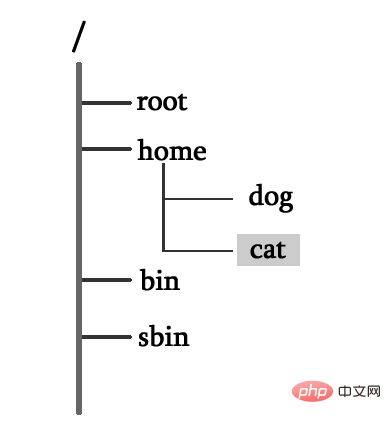 Operation and Maintenance
Operation and Maintenance
 Linux Operation and Maintenance
Linux Operation and Maintenance
 What does '.' mean in linux file path
What does '.' mean in linux file path
What does '.' mean in linux file path
In Linux, the "." in the file path means "current directory". If the directory name starts with ".", it means that the directory is hidden; for example, "./file name" means the current directory. There is a specified file in the directory, ".." indicates the directory above the current directory.

#The operating environment of this tutorial: linux7.3 system, Dell G3 computer.
What does "." mean in the Linux file path
.Represents the current directory
./crack.py indicates that there is a crack in the current directory .py file (.py is the file suffix)..Represents the upper-level directory of the current directory../start means that there is a start file (or directory) in the current directory. It can also mean running a program and close it with ctrl c.
Extended knowledge: absolute paths and relative paths in Linux
In the Linux system, files are stored in directories, and directories can Stored in other directories, therefore, the user (or program) can use the file name and directory name to search and locate the desired directory or file starting from anywhere in the file tree.
There are two ways to specify the location of a directory or file name, using absolute paths and relative paths respectively. The absolute path refers to the file or directory name written starting from the root directory (/), while the relative path refers to the writing relative to the current path.
In other words, the absolute path must start with a forward slash (/), which is the root directory, and go to the name of each directory that must be passed to find the object (directory or file), which is the file location Complete waypoints, so in any case the required file can be found using the absolute path. For example:
[root@localhost ~]# cd /usr/local/src [root@localhost src]# cd /etc/rc.d/init.d
These methods of switching directories use absolute paths.
cd is a command to switch directories. The specific usage of this command will be introduced in detail in subsequent chapters.
The relative path does not start with a forward slash. It starts from the current directory and ends with the name of each directory that must be passed to find the object (directory or file). For example:
[root@localhost /]# cd etc #当前所在路径是/目录,而/目录下有etc目录,所以可以切换 [root@localhost etc]# cd etc -bash:cd:etc/:没有那个文件或目录 #而同样的命令,由于当前所在目录改变了,所以就算是同一个命令也会报错,除非在/etc/目录中还有一个etc目录
Normally, relative paths are shorter than absolute paths, which is why many users like to use relative paths.
The example is as follows:

Assume that the user's current directory is cat, and he wants to switch to the dog directory at this time. In this case, the switching path has the following two expressions:
Use an absolute path, written as: /home/dog, which means that the directory to be switched is the dog directory in the home directory under the root directory;
You can also use a relative path, written as: ../dog, where .. represents the parent directory of the current directory (home directory), that is, relative to the current directory cat, you need to switch to the parent directory. The dog directory under home.
Recommended learning: Linux video tutorial
The above is the detailed content of What does '.' mean in linux file path. For more information, please follow other related articles on the PHP Chinese website!

Hot AI Tools

Undresser.AI Undress
AI-powered app for creating realistic nude photos

AI Clothes Remover
Online AI tool for removing clothes from photos.

Undress AI Tool
Undress images for free

Clothoff.io
AI clothes remover

Video Face Swap
Swap faces in any video effortlessly with our completely free AI face swap tool!

Hot Article

Hot Tools

Notepad++7.3.1
Easy-to-use and free code editor

SublimeText3 Chinese version
Chinese version, very easy to use

Zend Studio 13.0.1
Powerful PHP integrated development environment

Dreamweaver CS6
Visual web development tools

SublimeText3 Mac version
God-level code editing software (SublimeText3)

Hot Topics
 What computer configuration is required for vscode
Apr 15, 2025 pm 09:48 PM
What computer configuration is required for vscode
Apr 15, 2025 pm 09:48 PM
VS Code system requirements: Operating system: Windows 10 and above, macOS 10.12 and above, Linux distribution processor: minimum 1.6 GHz, recommended 2.0 GHz and above memory: minimum 512 MB, recommended 4 GB and above storage space: minimum 250 MB, recommended 1 GB and above other requirements: stable network connection, Xorg/Wayland (Linux)
 Linux Architecture: Unveiling the 5 Basic Components
Apr 20, 2025 am 12:04 AM
Linux Architecture: Unveiling the 5 Basic Components
Apr 20, 2025 am 12:04 AM
The five basic components of the Linux system are: 1. Kernel, 2. System library, 3. System utilities, 4. Graphical user interface, 5. Applications. The kernel manages hardware resources, the system library provides precompiled functions, system utilities are used for system management, the GUI provides visual interaction, and applications use these components to implement functions.
 vscode terminal usage tutorial
Apr 15, 2025 pm 10:09 PM
vscode terminal usage tutorial
Apr 15, 2025 pm 10:09 PM
vscode built-in terminal is a development tool that allows running commands and scripts within the editor to simplify the development process. How to use vscode terminal: Open the terminal with the shortcut key (Ctrl/Cmd). Enter a command or run the script. Use hotkeys (such as Ctrl L to clear the terminal). Change the working directory (such as the cd command). Advanced features include debug mode, automatic code snippet completion, and interactive command history.
 How to check the warehouse address of git
Apr 17, 2025 pm 01:54 PM
How to check the warehouse address of git
Apr 17, 2025 pm 01:54 PM
To view the Git repository address, perform the following steps: 1. Open the command line and navigate to the repository directory; 2. Run the "git remote -v" command; 3. View the repository name in the output and its corresponding address.
 Where to write code in vscode
Apr 15, 2025 pm 09:54 PM
Where to write code in vscode
Apr 15, 2025 pm 09:54 PM
Writing code in Visual Studio Code (VSCode) is simple and easy to use. Just install VSCode, create a project, select a language, create a file, write code, save and run it. The advantages of VSCode include cross-platform, free and open source, powerful features, rich extensions, and lightweight and fast.
 How to run java code in notepad
Apr 16, 2025 pm 07:39 PM
How to run java code in notepad
Apr 16, 2025 pm 07:39 PM
Although Notepad cannot run Java code directly, it can be achieved by using other tools: using the command line compiler (javac) to generate a bytecode file (filename.class). Use the Java interpreter (java) to interpret bytecode, execute the code, and output the result.
 What is the main purpose of Linux?
Apr 16, 2025 am 12:19 AM
What is the main purpose of Linux?
Apr 16, 2025 am 12:19 AM
The main uses of Linux include: 1. Server operating system, 2. Embedded system, 3. Desktop operating system, 4. Development and testing environment. Linux excels in these areas, providing stability, security and efficient development tools.
 How to run sublime after writing the code
Apr 16, 2025 am 08:51 AM
How to run sublime after writing the code
Apr 16, 2025 am 08:51 AM
There are six ways to run code in Sublime: through hotkeys, menus, build systems, command lines, set default build systems, and custom build commands, and run individual files/projects by right-clicking on projects/files. The build system availability depends on the installation of Sublime Text.





